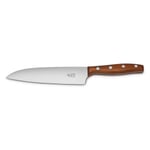Herder chef's knife K5 HRC 60 blue pierced

Herder chef's knife K5 HRC 60 blue pierced
- Highly functional all-purpose knife in professional design
- Extremely sharp: blue-serrated carbon steel blade
- High cutting retention thanks to material-induced self-sharpening effect
General Information
Knife handles made of steamed, finely polished wood are rare. Knife handles made of steamed, finely polished apple tree wood are even rarer because apple tree wood, since it dries slowly, is not one of the typical commercial woods. However, it is very easy to work with due to its hardness, weight and durability. Herder in Solingen manufactures these knife handles with rarity value exclusively for Manufactum: even oiled for better surface protection.
Favorite on the chopping board
The blade shape is taken from the professional "couteau de chef", but here it is slightly shorter and less heavy. The wide blade (up to 2.8 mm thick), which is tapered up to the tip of the knife, allows the knife to be held securely by the hand holding the food to be cut. The curved blade contour towards the tip also makes this knife ideal for use as a weighing knife.
Solingen thin grind: nail-thin and scrape-free
The Windmühlen knives from Robert Herder in Solingen are remarkable not only because of the knife steel (at least 0.75% carbon content and a hardness of at least 56 HRC for the carbon steels), but above all because of the craftsmanship, which spares none of the traditional grinding efforts: Windmühlen knives are ground extremely thin. This results in their astonishing cutting ability, which is an experience in use. The most elaborate type of sharpening is fuller grinding, a special type of thin grinding in which the blade is tapered towards the back of the knife.
Blaugepließtet
In Solingen, the process of smoothing the grinding grooves remaining on the blade is known as flattening, i.e. fine grinding. The most complex stage of this technique is blue polishing. The steel is ground finer step by step. You can tell that a blade is blue-fluted because it reflects slightly blue in the light.
Sharp for longer thanks to greater hardness
The elastic blades of the blue-blued knives from Herder are ground using the Solingen thin grind and fuller's edge. Thanks to the very high hardness of 60 Rockwell (HRC), they keep their sharpness significantly longer. However: Due to the high hardness - and precisely because they are ground so extremely thin - the blades should not be twisted or even tilted, as this can lead to chipping of the material when cutting.
Not stainless, but really sharp
The traditional material for knife blades is carbon steel. It is not rustproof, but with a fine-grained structure it can be hardened to a particularly high degree and made extremely sharp. The higher the carbon content, the higher the hardening capacity. These knives owe their high cutting ability to the material in addition to the finish, and their high cutting edge retention to a material-related self-sharpening effect. Each time a cut is made through fruit or vegetables, a minimal amount of material is removed and the blade wears evenly. The knifemaker refers to this as micro-corrosion. In fact, this means that the blade becomes steadily narrower over the years - but always retains its sharp grinding angle. Blades made of carbon steel acquire a dark patina over time, but this in no way negatively affects their quality; on the contrary, it gives them better protection against corrosion.
Care instructions:
Carbon steel knives do not belong in the dishwasher. Wipe the knives dry after rinsing and occasionally apply some blade oil. Discoloration may occur on the blade material. However, this is not a sign of inferior quality, but only indicates the rather high carbon content in the material. In case of flash rust, the use of the rust eraser is recommended. A resharpening can be done with the sharpening steel.
Product Information
Article Number 41247
- Highly functional all-purpose knife in professional design
- Extremely sharp: blue-serrated carbon steel blade
- High cutting retention thanks to material-induced self-sharpening effect
The blade form is derived from the professional "couteau de chef", in this case somewhat shorter in design and not as heavy. The wide tapered ground blade running up to the tip (up to 2.8 mm thick) makes for a steady grip on the cutting material. With the crescent shaped contour running out to the tip of the blade the knife is well suited for mincing.
Blue glazed carbon steel blade. Handle halves made of steamed apple wood.
Blade length 17.5 cm, overall length 30 cm. Weight 170 g.
Have a question?
If you have a question concerning this product you are welcome to contact us. For this your E-Mail program will open.
Contact Us
For advice, spare parts or special requests - our customer service will take care of your questions and concerns, personally and competently.
You can reach us from Monday to Friday at +49 2309 939095 or anytime at info@manufactum.com
Exclusive at Manufactum
Several particularly noteworthy products from selected manufacturers are available from us in a distinct form. In any case, these special editions offer you a maximum of quality in material and functionality.
Find exclusive products


